GIGABYTE Server MD60-SC0 Motherboard Review: Haswell-EP with QSFP
by Ian Cutress on December 3, 2014 10:00 AM ESTCPU Benchmarks
Readers of our motherboard review section will have noted the trend in modern motherboards to implement a form of MultiCore Enhancement / Acceleration / Turbo (read our report here) on their motherboards. This does several things, including better benchmark results at stock settings (not entirely needed if overclocking is an end-user goal) at the expense of heat and temperature. It also gives in essence an automatic overclock which may be against what the user wants. Our testing methodology is ‘out-of-the-box’, with the latest public BIOS installed and XMP enabled, and thus subject to the whims of this feature. It is ultimately up to the motherboard manufacturer to take this risk – and manufacturers taking risks in the setup is something they do on every product (think C-state settings, USB priority, DPC Latency / monitoring priority, memory subtimings at JEDEC). Processor speed change is part of that risk, and ultimately if no overclocking is planned, some motherboards will affect how fast that shiny new processor goes and can be an important factor in the system build.
Point Calculations – 3D Movement Algorithm Test: link
3DPM is a self-penned benchmark, taking basic 3D movement algorithms used in Brownian Motion simulations and testing them for speed. High floating point performance, MHz and IPC wins in the single thread version, whereas the multithread version has to handle the threads and loves more cores.
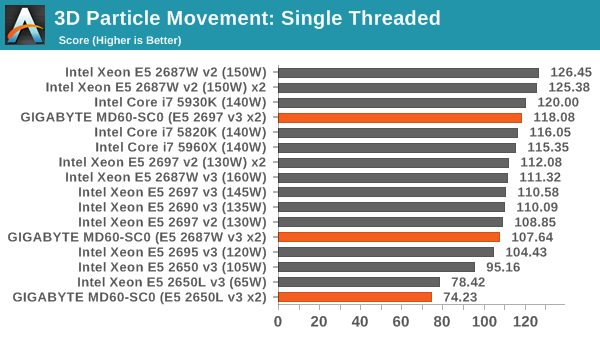
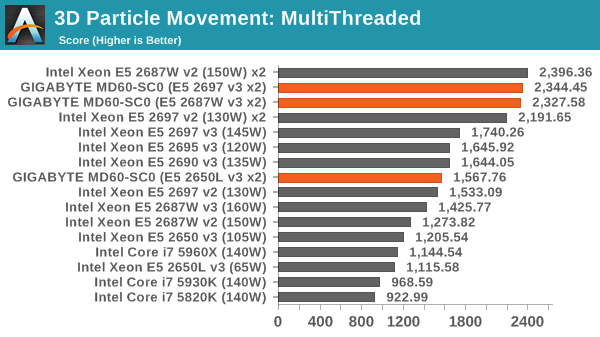
Compression – WinRAR 5.0.1: link
Our WinRAR test from 2013 is updated to the latest version of WinRAR at the start of 2014. We compress a set of 2867 files across 320 folders totaling 1.52 GB in size – 95% of these files are small typical website files, and the rest (90% of the size) are small 30 second 720p videos.
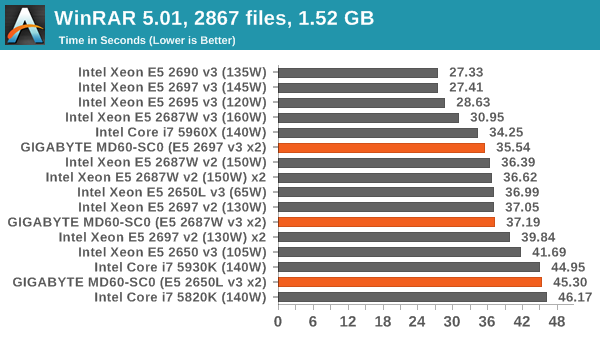
Image Manipulation – FastStone Image Viewer 4.9: link
Similarly to WinRAR, the FastStone test us updated for 2014 to the latest version. FastStone is the program I use to perform quick or bulk actions on images, such as resizing, adjusting for color and cropping. In our test we take a series of 170 images in various sizes and formats and convert them all into 640x480 .gif files, maintaining the aspect ratio. FastStone does not use multithreading for this test, and thus single threaded performance is often the winner.
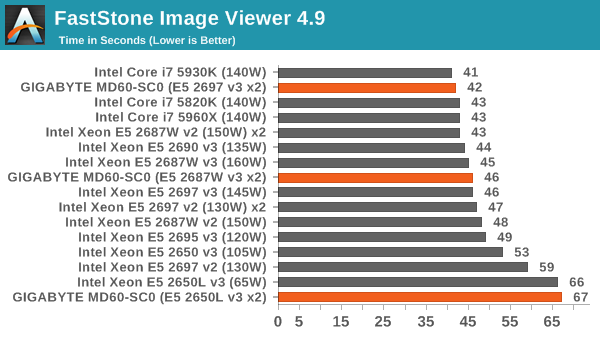
Video Conversion – Handbrake v0.9.9: link
Handbrake is a media conversion tool that was initially designed to help DVD ISOs and Video CDs into more common video formats. The principle today is still the same, primarily as an output for H.264 + AAC/MP3 audio within an MKV container. In our test we use the same videos as in the Xilisoft test, and results are given in frames per second.
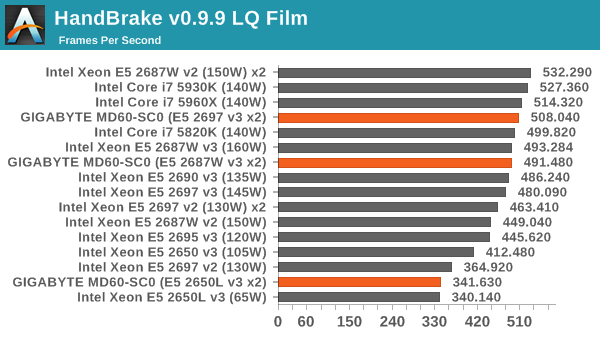
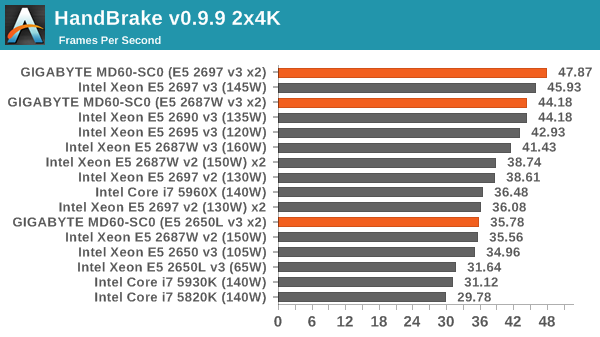
Rendering – PovRay 3.7: link
The Persistence of Vision RayTracer, or PovRay, is a freeware package for as the name suggests, ray tracing. It is a pure renderer, rather than modeling software, but the latest beta version contains a handy benchmark for stressing all processing threads on a platform. We have been using this test in motherboard reviews to test memory stability at various CPU speeds to good effect – if it passes the test, the IMC in the CPU is stable for a given CPU speed. As a CPU test, it runs for approximately 2-3 minutes on high end platforms.

Synthetic – 7-Zip 9.2: link
As an open source compression tool, 7-Zip is a popular tool for making sets of files easier to handle and transfer. The software offers up its own benchmark, to which we report the result.











17 Comments
View All Comments
macwhiz - Wednesday, December 3, 2014 - link
I'm not surprised that there's no temperature data in the BIOS. Server admins don't look at the BIOS after they complete initial setup (or a major overhaul). It's accessible from the BMC, where it's useful in a server environment. When a server overheats, the admin is usually not in the same room—and often not in the same building, or even the same state. The important question is how the BMC firmware does at exposing that data for out-of-band management via IPMI, SNMP, or another standard solution. Does it play well with an Avocent UMG managment device, for instance? As a server admin, I could care less about seeing the temperature in the BIOS. What I care about is that my chosen monitoring solution can see if the temperature is going up—or any hardware fault is detected—and page me, even if the operating system isn't running. That's what BMCs are for!Don't apologize for using 240VAC power. Chances are very good that, even in a U.S. data center, it'll be on 240VAC power. Given the current needs of most servers, it's impractical to use 120VAC power in server racks—you'll run out of available amperage on your 120VAC power-distribution unit (power strip) long before you use all the outlets. Keep going down that road and you waste rack space powering PDUs with two or three cords plugged into them. It's much easier and more efficient all the way around to use 240VAC PDUs and power in the data center. Comparing a 20-amp 120V circuit to a 20-amp 240V circuit, you can plug at least twice as many of a given server model into the 240V circuit. Because the U.S. National Electrical Code restricts you to using no more than 80% of the rated circuit capacity for a constant load, you can plug in 16A of load on that 20A circuit. If the servers draw 6A at 120V or 3A at 240V, you can plug in two servers to the 120V power strip, or five servers into the 240V strip, before you overload it. So, once you get beyond a handful of computers, 240V is the way to go in the datacenter (if you're using AC power).
leexgx - Wednesday, December 3, 2014 - link
mass server racks are Pure DC in some cases or 240v (i would of thought there be some very basic Temp monitoring in the BIOS but guess most of this is exposed elsewhereso i agree with this post
jhh - Thursday, December 4, 2014 - link
208V 3-phase is probably more popular than 240V, as most electricity is generated as 3-phase, and using all 3 phases is important for efficiently using the power without being charged for a poor power factor.mapesdhs - Thursday, December 4, 2014 - link
In, you're still using the wrong source link for the C-ray test. The Blinkenlights site is
a mirror over which I have no control; I keep the main c-ray page on my SGI site.
Google for, "sgidepot 'c-ray'", 1st hit will be the correct URL.
Apart from that, thanks for the review!
One question: will you ever be able to review any quad-socket systems or higher?
I'd love to know how well some of the other tests scale, especially CB R15.
Ian.
fackamato - Friday, December 5, 2014 - link
No 40Gb benchmarks?sor - Monday, December 8, 2014 - link
I was excited to see the QSFP, but it seems like it's not put to use. I've been loving our mellanox switches, they have QSFP and you can run 40Gbe or 4 x 10Gbe with a breakout cable, with each port. It provides absolutely ridiculous port density and great cost. You can find SX1012s (12 port QSFP) for under $5k, and have 48 10G ports in 1/2U at about $100/port. No funny business with extra costs to license ports. The twinax cable is much cheaper than buying 10G optics, too, but you have to stay close. Usually you only need fibre on the uplinks, anyway.dasco - Saturday, March 9, 2019 - link
Does it support udimm. As the documentation says that it supports only rdimm or lrdimm.Does gskill ram used in this test is udimm or rdimm Ecc ram.